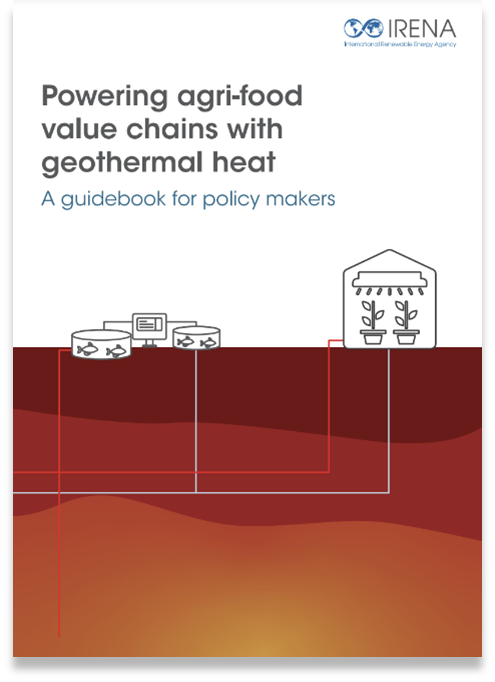- Session I at 10:00 East Africa Time
- Session II at 14:00h East Africa Time
- Currently, the main geothermal agri-food applications in the region include drying of food, and heating of greenhouses and aquaculture facilities.
- With increased support in areas such as geothermal resource mapping, establishment of enabling policies and regulations, access to financing, and capacity building, more significant progress can be achieved.
In this regard, a webinar on “Powering Agri-food Value Chains with Geothermal Heat – Africa,” organised in the framework of the Global Geothermal Alliance by IRENA in collaboration with its partners in the Africa, aims to share recommendations as well as global experiences and best practices for accelerating the use of geothermal heat in the agri-food sector.

Ndetei, C. (2016), “Opportunities for direct utilization of geothermal energy in Eburru Area, Nakuru County in
Kenya”, Proceedings of the 6th African Rift Geothermal Conference Addis Ababa.
Uwera, J. et al. (2015), “Design of a cooling system using geothermal energy for storage of agricultural products
This report is a guidebook for policy makers which provides recommendations for accelerating the deployment of geothermal energy in the agri-food value chains. The recommendations are derived from an analysis of key success factors that enabled the development of various agri-food applications in different part of the world.
The guidebook benefited from the input of 23 experts drawn from 17 member countries and partner organisations of the GGA, and other organisations.
"The establishment of a geothermal agricultural processor such as a crop drying centre or milk pasteurisation creates a new market for local farmers to sell their raw materials to agro-industries. Perishable products such as fish, grains, fruits, and vegetables, once processed using geothermal energy, can be transported to new markets while still fresh as a result of improved shelf life." (page 76)
Extract:
Clean energy financing mechanisms (page 54)
finance solution managed by the International Renewable Energy Agency to advance the energy transition across the Agency’s 166-strong membership.
- Pure grants This is a form of supporting instrument whereby the supporting entity provides funding to risky activities such as initial exploration and initial drilling. The grantors are typically governments or international development organisations that wish to foster the development of geothermal in a given country or region. Grants have no strings attached as long as the work is performed as contemplated. This type of financing is exclusive to the initial stage of geothermal projects.
- Contingent grants This financial instrument is a variation on pure grants, whereby the grant has some conditions associated with it. Contingent grants are typically provided during the exploration and initial drilling stage. If drilling is unsuccessful, the grantee has no monetary obligations; if the operation is successful (i.e. the drilling activity funded by the grant leads to a project coming online), however, the grant converts into a loan that the grantee will repay over time. The rationale here is that the proceeds from this grant/loan can be recycled to provide support to more projects.
- Risk
mitigation
There are two types of mechanisms to encourage investors to engage in the drilling phase:
Insurance: The insured pays a one-time premium prior to the start of drilling. Once the drilling is complete, the well is tested as agreed upon in advance. If the results are not satisfactory (i.e. if the well was drilled according to the agreed-upon parameters and is dry), the insurance company will pay the insured a one-time payment to cover the cost of the well(s) and associated expenses.
Grants: Under this mechanism, the qualified applicants can obtain a grant covering the costs of the initial drilling and other related expenses. - Concessional loan A concessional loan is a loan at below-market conditions – i.e. lower interest rate, longer maturity and no or very light securities and collaterals. This instrument is available at later stages of project development when part or all of the resource has been fully developed. Hence, the proceeds from the loan will be used to construct the facility. The loan will be repaid from the profits of the operation. National development banks typically provide such loans because they can borrow at very low rates and are not mandated to maximise profits as the first priority (vis-à-vis commercial banks).
- Project financing Once the drilling phase of a geothermal project is completed and has passed the necessary acceptance tests, it can use the combination of equity and debt for further financing requirements. In developing countries, multilateral or regional development banks typically offer project debt (e.g. African Development Bank, International Finance Corporation, etc.). Equity is usually provided by investors focused on emerging markets. Project financing allows the project assets as the only collateral for the financing but can be time consuming and expensive.
finance solution managed by the International Renewable Energy Agency to advance the energy transition across the Agency’s 166-strong membership.



No comments:
Post a Comment